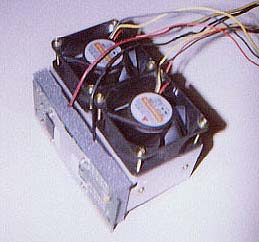Sharky Extreme heeft een review geproduceerd van de PC-10 Slot-1 Peltier cooler. Deze cooler is opgebouwd uit een Alpha P3125 heatsink, 2 60mm fans, een 70 watt Peltier element en een koperen cold plate ![]() .
.
For years now, heatsinks have been used to thermally protect delicate electronic components in stereos, computers, and even airplanes. As the heat builds up on a centralized location, it is transferred (usually with the assistance of thermal grease) to the heatsink, which has a greater surface area, facilitating better heat dissipation. Coupled with a fan, a heatsink can disperse even more effectively, keeping the temperature of your 28 million transistor CPU reasonably low.
The reason overclockers value a good heatsink is a simple matter of physics. By increasing the core frequency of a processor, more heat is generated; unfortunately, heat is the primary enemy of a semiconductor.
As more heat is introduced to the delicate circuitry of a CPU, the electronic signal traveling through it becomes weak, and the whole system locks up. In order to boost the strength of the signal, more voltage is supplied. Again, delta H (change in heat) is increased and the problem manifests itself even more rapidly.
Theoretically, a heatsink can only bring the processor down to room temperature, although this rarely happens. More commonly, the core is cooled 5-15 degrees F, depending on the size of the sink. Starved for a more effective method of cooling, the overclocking community has produced water coolers, vapor phase refrigeration (Kryotech's claim to fame), and the esteemed Peltier cooler. All three types have their pros and cons; however, using a Peltier cooler is the most economical choice for the overclocking enthusiast.
 |
